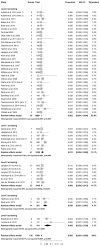Prevalence of Failure due to Adverse Reaction to Metal Debris in Modern, Medium and Large Diameter Metal-on-Metal Hip Replacements--The Effect of Novel Screening Methods: Systematic Review and Metaregression Analysis
- PMID: 26930057
- PMCID: PMC4773181
- DOI: 10.1371/journal.pone.0147872
Prevalence of Failure due to Adverse Reaction to Metal Debris in Modern, Medium and Large Diameter Metal-on-Metal Hip Replacements--The Effect of Novel Screening Methods: Systematic Review and Metaregression Analysis
Abstract
Metal-on-metal (MoM) hip replacements were used for almost a decade before adverse reactions to metal debris (ARMD) were found to be a true clinical problem. Currently, there is a paucity of evidence regarding the usefulness of systematic screening for ARMD. We implemented a systematic review and meta-analysis to establish the prevalence of revision confirmed ARMD stratified by the use of different screening protocols in patients with MoM hip replacements. Five levels of screening were identified: no screening (level 0), targeted blood metal ion measurement and/or cross-sectional imaging (level 1), metal ion measurement without imaging (level 2), metal ion measurement with targeted imaging (level 3) and comprehensive screening (both metal ions and imaging for all; level 4). 122 studies meeting our eligibility criteria were included in analysis. These studies included 144 study arms: 100 study arms with hip resurfacings, 33 study arms with large-diameter MoM total hip replacements (THR), and 11 study arms with medium-diameter MoM THRs. For hip resurfacing, the lowest prevalence of ARMD was seen with level 0 screening (pooled prevalence 0.13%) and the highest with level 4 screening (pooled prevalace 9.49%). Pooled prevalence of ARMD with level 0 screening was 0.29% and with level 4 screening 21.3% in the large-diameter MoM THR group. In metaregression analysis of hip resurfacings, level 4 screening was superior with regard to prevalence of ARMD when compared with other levels. In the large diameter THR group level 4 screening was superior to screening 0,2 and 3. These outcomes were irrespective of follow-up time or study publication year. With hip resurfacings, routine cross-sectional imaging regardless of clinical findings is advisable. It is clear, however, that targeted metal ion measurement and/or imaging is not sufficient in the screening for ARMD in any implant concepts. However, economic aspects should be weighed when choosing the preferred screening level.
Conflict of interest statement
Figures





Similar articles
-
Revision of metal-on-metal hip replacements and resurfacings for adverse reaction to metal debris: a systematic review of outcomes.Hip Int. 2014 Jul-Aug;24(4):311-20. doi: 10.5301/hipint.5000140. Epub 2014 May 23. Hip Int. 2014. PMID: 24970319
-
Systemic pharmacological treatments for chronic plaque psoriasis: a network meta-analysis.Cochrane Database Syst Rev. 2021 Apr 19;4(4):CD011535. doi: 10.1002/14651858.CD011535.pub4. Cochrane Database Syst Rev. 2021. Update in: Cochrane Database Syst Rev. 2022 May 23;5:CD011535. doi: 10.1002/14651858.CD011535.pub5. PMID: 33871055 Free PMC article. Updated.
-
Home treatment for mental health problems: a systematic review.Health Technol Assess. 2001;5(15):1-139. doi: 10.3310/hta5150. Health Technol Assess. 2001. PMID: 11532236
-
Systemic pharmacological treatments for chronic plaque psoriasis: a network meta-analysis.Cochrane Database Syst Rev. 2017 Dec 22;12(12):CD011535. doi: 10.1002/14651858.CD011535.pub2. Cochrane Database Syst Rev. 2017. Update in: Cochrane Database Syst Rev. 2020 Jan 9;1:CD011535. doi: 10.1002/14651858.CD011535.pub3. PMID: 29271481 Free PMC article. Updated.
-
Increased Mortality in Metal-on-Metal versus Non-Metal-on-Metal Primary Total Hip Arthroplasty at 10 Years and Longer Follow-Up: A Systematic Review and Meta-Analysis.PLoS One. 2016 Jun 13;11(6):e0156051. doi: 10.1371/journal.pone.0156051. eCollection 2016. PLoS One. 2016. PMID: 27295038 Free PMC article.
Cited by
-
Small-head metal on metal total hip arthroplasty is associated with a high rate of complication and reoperation at mid-term follow-up.SAGE Open Med. 2021 May 16;9:20503121211014707. doi: 10.1177/20503121211014707. eCollection 2021. SAGE Open Med. 2021. PMID: 34035911 Free PMC article.
-
Metal Ion Release, Clinical and Radiological Outcomes in Large Diameter Metal-on-Metal Total Hip Arthroplasty at Long-Term Follow-Up.Diagnostics (Basel). 2020 Nov 12;10(11):941. doi: 10.3390/diagnostics10110941. Diagnostics (Basel). 2020. PMID: 33198180 Free PMC article.
-
Outcomes of patients with unexpected diagnosis of infection at total hip or total knee arthroplasty revisions.Int Orthop. 2021 Nov;45(11):2791-2796. doi: 10.1007/s00264-021-05137-8. Epub 2021 Jul 22. Int Orthop. 2021. PMID: 34292384
-
Blood cytokine pattern and clinical outcome in knee arthroplasty patients: comparative analysis 5 years after standard versus "hypoallergenic" surface coated prosthesis implantation.Acta Orthop. 2018 Dec;89(6):646-651. doi: 10.1080/17453674.2018.1518802. Epub 2018 Oct 29. Acta Orthop. 2018. PMID: 30372661 Free PMC article.
-
Retention of metals in periprosthetic tissues of patients with metal-on-metal total hip arthroplasty is reflected in the synovial fluid to blood cobalt transfer ratio in the presence of a pseudotumour.BMC Musculoskelet Disord. 2020 Sep 12;21(1):610. doi: 10.1186/s12891-020-03636-0. BMC Musculoskelet Disord. 2020. PMID: 32919463 Free PMC article.
References
-
- Grigoris P, Roberts P, Panousis K, Jin Z. Hip resurfacing arthroplasty: the evolution of contemporary designs. Proc Inst Mech Eng H. 2006;220: 95–105. - PubMed
Publication types
MeSH terms
LinkOut - more resources
Full Text Sources
Other Literature Sources

